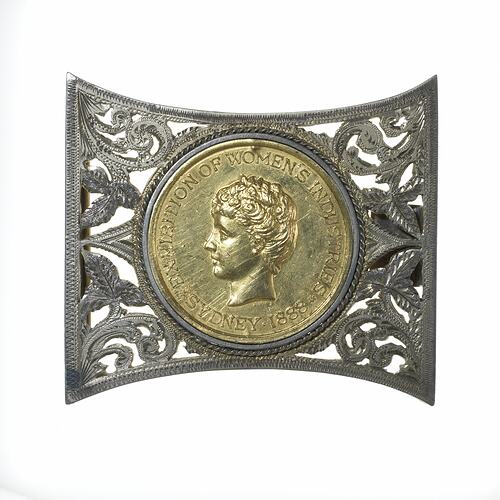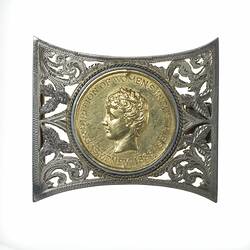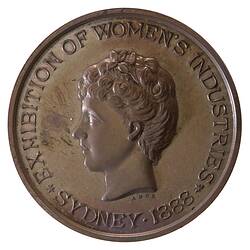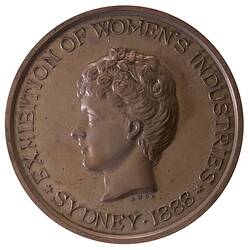Cecilia Baring was the first daughter of Baron Suffield and his wife Cecilia. She married Baron Charles Robert Carrington at Whitehall, London, in 1878, in front of 'no less than ten members of the Royal family'. In 1885 the Baron was appointed governor of New South Wales, and the Carringtons arrived in Sydney in December that year. The vice-regal couple soon earned a reputation for their hospitality at Government House and their work for the needy. Lady Carrington established the Jubilee Fund to relieve distressed women, and her management of the Fund surprised her contemporaries, who noted that she showed 'a business capacity for which women are rarely credited'. In 1887 she held a banquet for 1,000 poor boys to mark Queen Victoria's jubilee. They were given medals struck for the occasion, and told of the Carrington family's humble origins in England.
In 1888 Lady Carrington presided over the Exhibition of Women's Industries in Sydney, held during October at Prince Albert Park, Redfern. The Exhibition was housed in the 1870 Intercolonial Exhibition Building (demolished 1954), and was the closing event in the celebrations for the centenary of the settlement of Sydney. Lady Carrington formed a committee that elected her president; she also formed other organisational committees. She was depicted on the prize-winners' medal. Lady Mary Elizabeth (Bolton) Windeyer (1836 - 1912) was a principle organiser. She was a philanthropist and charity worker, and Foundation President of the Womanhood Suffrage League of New South Wales.
The Exhibition was structured with Patrons, including the Governor, Chief Justice and Sir Henry Parkes. The seven competitive departments within the Exhibition were each open to school pupils, girls and women of all backgrounds. The departments comprised needlework and lace, knitting, domestic industries (cooking and confectionary), mechanical work (typewriting, box and toy making), educational (especially sick nursing and ambulance work), horticulture and floriculture and fine arts (paintings, drawings, photography and pottery). Each department had an assigned delegate. Lady Carrington was delegate for horticulture and floriculture.
The Exhibition's motto was 'Patience, Work and God's Grace'. It included a series of auctions, cooking demonstrations, lectures on food and temperance, concerts of singing and other music, dramatic performances, comedies and award ceremonies.
The Exhibition opened on Tuesday 2 October, with a ceremony performed by Lady Carrington. A 100-voice choir sang, accompanied by the Permanent Artillery Band.
The Exhibition received considerable praise. It was free to children, although too expensive for working class women who also faced a rail fare to the venue. One newspaper correspondent commented that women touted their wares at the exhibition as if it was a common flea market. Nevertheless, it drew close to 3,000 people each day, and its net profit of 6,000 pounds was donated to charity, as well as a further 1,000 pounds from the drawing of the Art Union. Competitive prize medals were struck by W.J. Amor in gold, silver and bronze. About 15 gold, and 250 each of silver and bronze were struck.
The Carringtons returned to England in 1890. Lord Carrington died in 1928, after a long and successful political career. Lady Carrington survived him, together with four of their five daughters. Their only son was killed in World War I.
References:
Smith, R.A. (1997). 'Sydney Women's Exhibition Medal'. Australian Coin Review.
Australian Dictionary of Biography website http://adbonline.anu.edu.au/adbonline.htm
1887 'THE CELEBRATION OF THE QUEEN'S JUBILEE.', The Argus (Melbourne, Vic. : 1848 - 1957), 28 June, p. 9. , viewed 15 Jun 2022, http://nla.gov.au/nla.news-article7934928
More Information
-
Keywords
-
Localities
-
Authors
-
Article types




